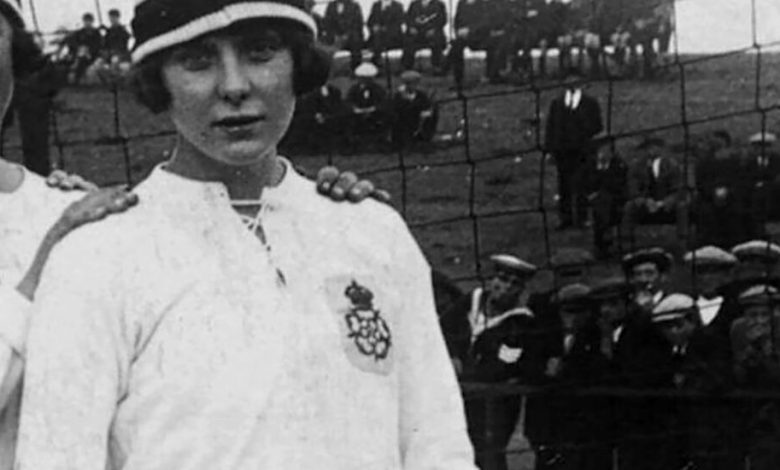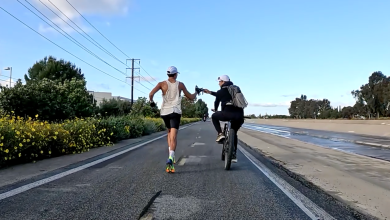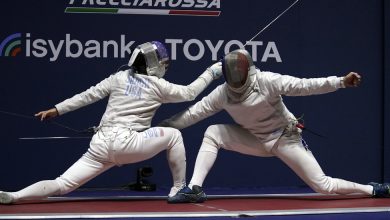Overlooked No More: Lily Parr, Dominant British Soccer Player

This article is part of Overlooked, a series of obituaries about remarkable people whose deaths, beginning in 1851, went unreported in The Times.
In 1921, the Football Association, English soccer’s ruling body, effectively banned women from playing the sport, deeming it “quite unsuitable for females.” But by then, a standout player named Lily Parr had already gained fame for her skill on the field.
Her renown was part of the growth of women’s soccer at the time, exemplified by a match in which she played at Goodison Park in Liverpool that drew a crowd of about 53,000, with thousands more outside the stadium. (It would remain the largest crowd for a women’s club soccer match for 99 years, until Atlético Madrid hosted Barcelona in front of 60,739 fans in March 2019.)
Though the association’s ban would hamper Parr’s career, barring her and other women from playing in stadiums, she competed where she could, in fields and parks in England and abroad, and continued drawing attention over her 31 years with the same team, Dick, Kerr Ladies Football Club.
In 1927, the English newspaper The Leicester Mail called her “a remarkably nimble and speedy performer” with “a kick like a cart-horse.” By the time she retired from soccer, in 1951, she had scored an estimated 1,000 goals.
Parr was “a great player in a great team,” said Gail Newsham, author of the 1994 book “In a League of Their Own!: The Dick, Kerr Ladies 1917-1965,” and she contributed to the club’s immense success alongside other star goal scorers like Florrie Redford, Jennie Harris and Alice Kell, the team’s longest serving captain.
Soccer officials began lifting the ban in England — as well as those in other countries — in the 1970s. The first official Women’s World Cup was held in 1991, and interest in the event has grown considerably since then.
This year, the Women’s World Cup, which is currently underway in Australia and New Zealand, includes an expanded field of 32 teams, up from 24.
Club competition in England has grown, too; the Women’s Super League, which began in 2011, became fully professional in 2018. In the United States, the National Women’s Soccer League began in 2013.
In 2002, Parr became the first woman inducted into England’s National Football Museum Hall of Fame, now in Manchester, and in 2019, the museum installed a life-size statue of her there, also a first for a British female soccer player.
“We have come a long way since Lily Parr’s days, and she deserves recognition as a true pioneer of the sport,” Marzena Bogdanowicz, a spokeswoman for women’s soccer at the Football Association, was quoted as saying in The Guardian in 2019.
Lilian Parr was born on April 26, 1905, in St Helens, about 10 miles northeast of Liverpool, to Sarah and George Parr, a glassworks laborer. Growing up, she played soccer in the street with her brothers.
Women had been playing soccer in Britain since the late 19th century, but World War I offered an opportunity for them to blossom. As men were sent to fight and women filled the country’s factories, the government encouraged soccer as an after-work activity.
Parr went to work for Dick, Kerr & Co., a locomotives factory that had switched production to munitions during the war, and joined the company’s team as a left back when she was about 15.
Her manner could be rough and abrupt, but with a quick wit and a dry sense of humor she enjoyed strong friendships with many of her teammates, Newsham wrote.
In one perhaps apocryphal story, the team was playing at Ashton Park in Preston, England, northwest of Manchester, when a male professional goalkeeper declared that a woman would never be able to score on a man. Parr, famous for her powerful left foot, accepted his challenge. She lined up to take a penalty kick against him and broke the man’s arm with her shot.
Parr, who later moved to left winger, exploded onto the scene in 1921.
On Feb. 5 that year, she scored a hat trick — three goals in a single match — at Nelson, England; she scored another three days later at Stalybridge in a 10-0 win. In a 9-1 win in Liverpool at Anfield Stadium the next week, she netted five goals against a team of all-stars assembled by the comedian Harry Weldon. That May she scored every goal in a 5-1 win over a visiting French team.
Parr’s shooting and crossing abilities, as well as her impressive physique (she was a sturdy 5 feet 10 inches tall or so), quickly made her a star, and she finished 1921 with 108 goals, according to Newsham.
That year the team won all 67 games it played and scored some 448 goals in the process while allowing just 22. Other players, including Redford and Harris, contributed to the team’s dominance. In one April 1921 match at Barrow, for example, the team won 14-2 with seven goals from Redford, four from Harris and three from Parr. Redford led the year’s scoring with a 170 goals.
On Dec. 5, 1921, the Football Association unanimously passed its resolution declaring that soccer “ought not to be encouraged” among women. It mandated that all of the association’s clubs “refuse the use of their grounds for such matches.” Because association clubs owned virtually all stadiums, women’s soccer on any significant scale was, in effect, banned.
Similar bans were common across the world for much of the 20th century. The momentum that had been building since World War I screeched to a halt, and the sport, for women, withered on the vine.
Parr’s team nevertheless continued to play in front of smaller crowds and on tours abroad. In 1922, she captained a trip to the United States. That October, the team tied a men’s team, 4-4, in Washington, D.C. Some sources suggest that President Warren G. Harding kicked off the game and autographed the match ball.
As she continued playing, Parr trained to be a nurse and worked at what was then known as Whittingham Hospital, a psychiatric facility northeast of Preston. Some have viewed Parr as a queer icon, but there is no evidence that she was gay.
“Like all our great football stars there are as many myths as there are facts, and we all embroider her story with our own influences,” said Jean Williams, a professor of sports history at the University of Wolverhampton. “That is why she means so much to so many.”
Parr’s career lasted into her 40s; she played her last game in 1951. In 1965, she retired from nursing. A few years later, she was diagnosed with breast cancer and underwent a double mastectomy. She lived to see the ban on women’s soccer lifted in 1971, but died of cancer on May 24, 1978, at her home in Preston. She was 73.
Only in recent decades has recognition of Parr and her club’s accomplishments gained momentum. Historical markers for her team are now at the Preston factory site, Preston North End’s stadium and Ashton Park. The English National Football Museum installed a permanent display about her life in 2021.
“Lily is a lens through which to look at the women’s game in the ’20s,” Belinda Scarlett, then the curator of women’s football at the museum, told The Guardian in 2020. “It will tell the stories of all the women she played with and against.”
She added that “women’s football probably wouldn’t have continued if those groups of women didn’t fight that ban and just play wherever the hell they could find a space to play football.”




